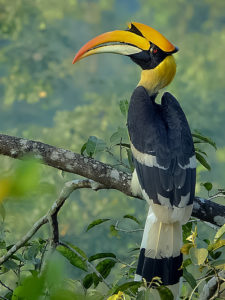UPSC Mains Answer Writing Practice Booklet: Pragati Notebooks – Spiral and Detachable sheets Click Here to know more and order
Source: TOI
About Great Hornbill:

- The great hornbill (Buceros bicornis) is also known as the concave-casqued hornbill, great Indian hornbill or great pied hornbill.
- It is one of the larger members of the hornbill family. It is found in the Indian subcontinent and Southeast Asia.
- The most prominent feature of the Great Hornbill is the bright yellow and black casque (hard structure on the head of some birds) on top of its massive bill.
- Festival: The Hornbill Festival celebrated in Nagaland is named after the bird – Hornbill, which is the most revered and admired bird for the Nagas.
- Cultural Symbol: They are the cultural symbols of some ethnic communities in the northeast, specifically the Nyishi of Arunachal Pradesh.
- State Bird: Great Hornbill is the state bird of Arunachal Pradesh and Kerala.
- IUCN Status: Vulnerable
- Indian Wildlife Protection Act,1972: Schedule I
About Pakke Tiger Reserve
About Eaglenest Wildlife Sanctuary:
- Eaglenest or Eagle’s Nest Wildlife Sanctuary is a protected area of India in the Himalayan foothills of West Kameng District, Arunachal Pradesh.
- It conjoins Sessa Orchid Sanctuary to the northeast and Pakhui Tiger Reserve across the Kameng river to the east. It is also a part of the Kameng Elephant Reserve.
- The sanctuary derives its name from the Red Eagle Division of the Indian army which was posted in the area in the 1950s.
- The sanctuary is notable as a prime birding site due to the extraordinary variety, numbers and accessibility of species.
- Eaglenest is the site where Bugun liocichla (a passerine bird species) was first discovered in 1995 and again observed and described in 2006.
Discover more from Free UPSC IAS Preparation Syllabus and Materials For Aspirants
Subscribe to get the latest posts sent to your email.







